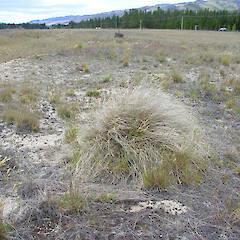Carex albula
Common name
white sedge
Synonyms
Carex comans var stricta Cheeseman
Family
Cyperaceae
Flora category
Vascular – Native
Endemic taxon
Yes
Endemic genus
No
Endemic family
No
Structural class
Sedges
NVS code
The National Vegetation Survey (NVS) Databank is a physical archive and electronic databank containing records of over 94,000 vegetation survey plots - including data from over 19,000 permanent plots. NVS maintains a standard set of species code abbreviations that correspond to standard scientific plant names from the Ngä Tipu o Aotearoa - New Zealand Plants database.
CARALB
Chromosome number
2n = c.60
Current conservation status
The conservation status of all known New Zealand vascular plant taxa at the rank of species and below were reassessed in 2017 using the New Zealand Threat Classification System (NZTCS) – more information about this can be found on the NZTCS website. This report includes a statistical summary and brief notes on changes since 2012 and replaces all previous NZTCS lists for vascular plants.
Please note, threat classifications are often suggested by authors when publications fall between NZTCS assessment periods – an interim threat classification status has not been assessed by the NZTCS panel.
- Conservation status of New Zealand indigenous vascular plants, 2017 . 2018. Peter J. de Lange, Jeremy R. Rolfe, John W. Barkla, Shannel P. Courtney, Paul D. Champion, Leon R. Perrie, Sarah M. Beadel, Kerry A. Ford, Ilse Breitwieser, Ines Schönberger, Rowan Hindmarsh-Walls, Peter B. Heenan and Kate Ladley. Department of Conservation. Source: NZTCS and licensed by DOC for reuse under the Creative Commons Attribution 4.0 International licence.
2017 | Threatened – Nationally Vulnerable | Qualifiers: Sp
Previous conservation statuses
2012 | At Risk – Declining | Qualifiers: DP, Sp
2009 | Data Deficient
2004 | Range Restricted
Distribution
Endemic. South Island in a narrow area from the Mackenzie Basin, Waitaki and Central Otago.
Habitat
A species of mainly alluvial terraces, colluvial slopes and river flats. It prefers free draining soils and is often a local component of grey scrub communities. Seemingly unpalatable it often persists in paddocks alongside cattle and sheep.
Detailed description
Stiffly erect to drooping, buff-coloured to almost bleached white, green or red, densely caespitose sedge, 250–350 mm tall. Culms 50–200 × 0.5 mm smooth, often with a deep groove; basal sheaths dark brown to purple-red. Leaves numerous, much > culms, 0.8–0.9–(1) mm wide, plano-convex, rigid, grooved, margins scabrid. Spikes 3–6–(8); terminal spike male; remaining spikes female, 5–20 × 3–5 mm, distant, upper spikes sessile to sub-sessile, lower spikes narrower, flattened, with scabrid peduncles. Glumes (excluding awn) slightly < utricle length, broadly ovate, acute, pale cream with a few to many scattered fine brown striae, chartaceous, nerves beside midrib usually indistinct, awn long and narrow, finely scabrid. Utricles 2.5–3 × 1.5 mm, plano-convex to subtrigonous, elliptic-ovoid, pale brown, nerved on the convex face towards margin; beak 0.5 mm, deeply bidentate with spreading crura, margins and crura scabrid. Stigmas 3. Nut 1.5 mm, light grey-brown, trigonous, oblong-ovoid.
Similar taxa
In the field most similar to either hard tussock Festuca novaezelandiae (which often has spikes visible above the leaves) or silver tussock Poa cita (which is usually a larger plant with typical grass flowers). Within the sedges most like Carex comans Bergg., C. albula is best distinguished from that species by the usually stiffly erect growth habit, pale foliage colour, and pale cream glumes. However some plants can also appear green or red and can only be distinguished from C. comans by the pale glume with small red flecks and by the obvious ven towards the margin of the outer face of the utricle. The peculiar bleached-white colour implied by the specific name is only apparent in some plants and is often imparted by the dead foliage (which is retained).
Flowering
October–December
Fruiting
October–September
Life cycle
Nuts surrounded by inflated utricles are dispersed by granivory and wind (Thorsen et al., 2009).
Propagation technique
Easily grown from the division of whole plants and from fresh seed. Best suited for a well drained, sunny site in dry climates. This species dislikes humidity and soon dies if kept too moist. An unusual sedge well worth cultivating.
Threats
A local regional endemic. Though it does not seem to be particularly palatable as it is often found in some abundance within pasture otherwise heavily cropped by sheep and/or cattle, plants have been lost to spraying and cultivation. It also does not seem to tolerate competition from taller species.
Etymology
carex: Latin name for a species of sedge, now applied to the whole group.
Attribution
Description adapted from Moore and Edgar (1970)
References and further reading
Moore LB, Edgar E. 1970. Flora of New Zealand, Volume II. Indigenous Tracheophyta: Monocotyledones except Gramineae. Government Printer, Wellington, NZ. 354 p.
Thorsen MJ, Dickinson KJM, Seddon PJ. 2009. Seed dispersal systems in the New Zealand flora. Perspectives in Plant Ecology, Evolution and Systematics 11: 285–309. https://doi.org/10.1016/j.ppees.2009.06.001.








